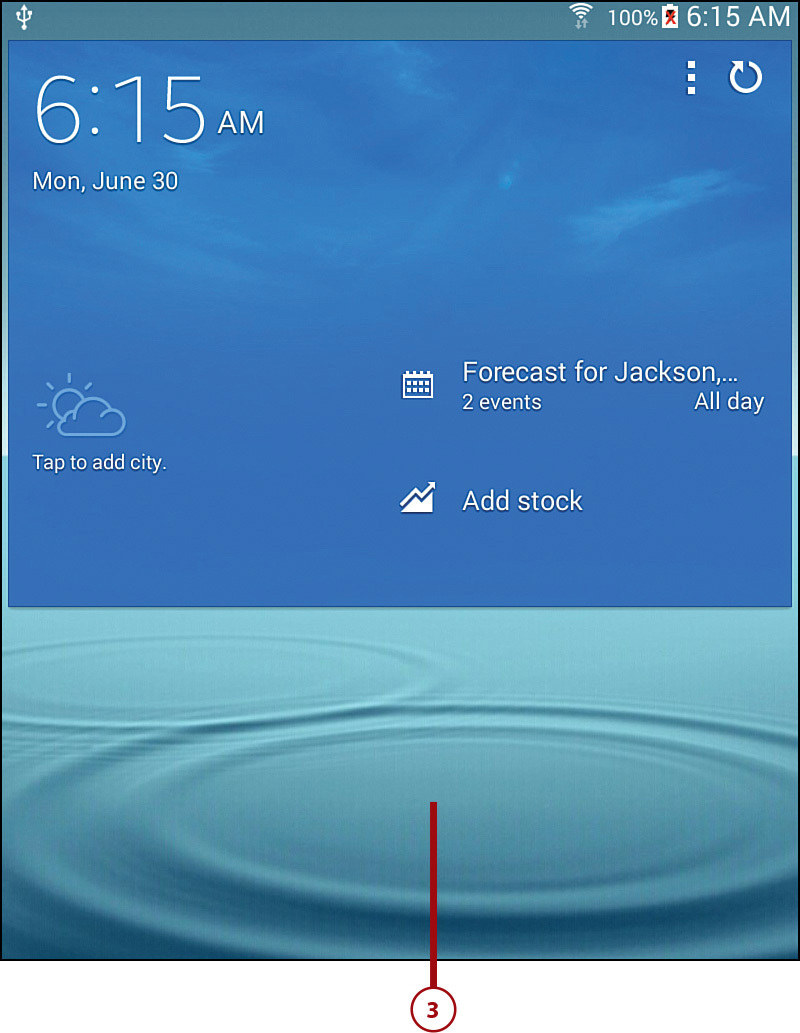5. Adding Widgets to Your Home Screens
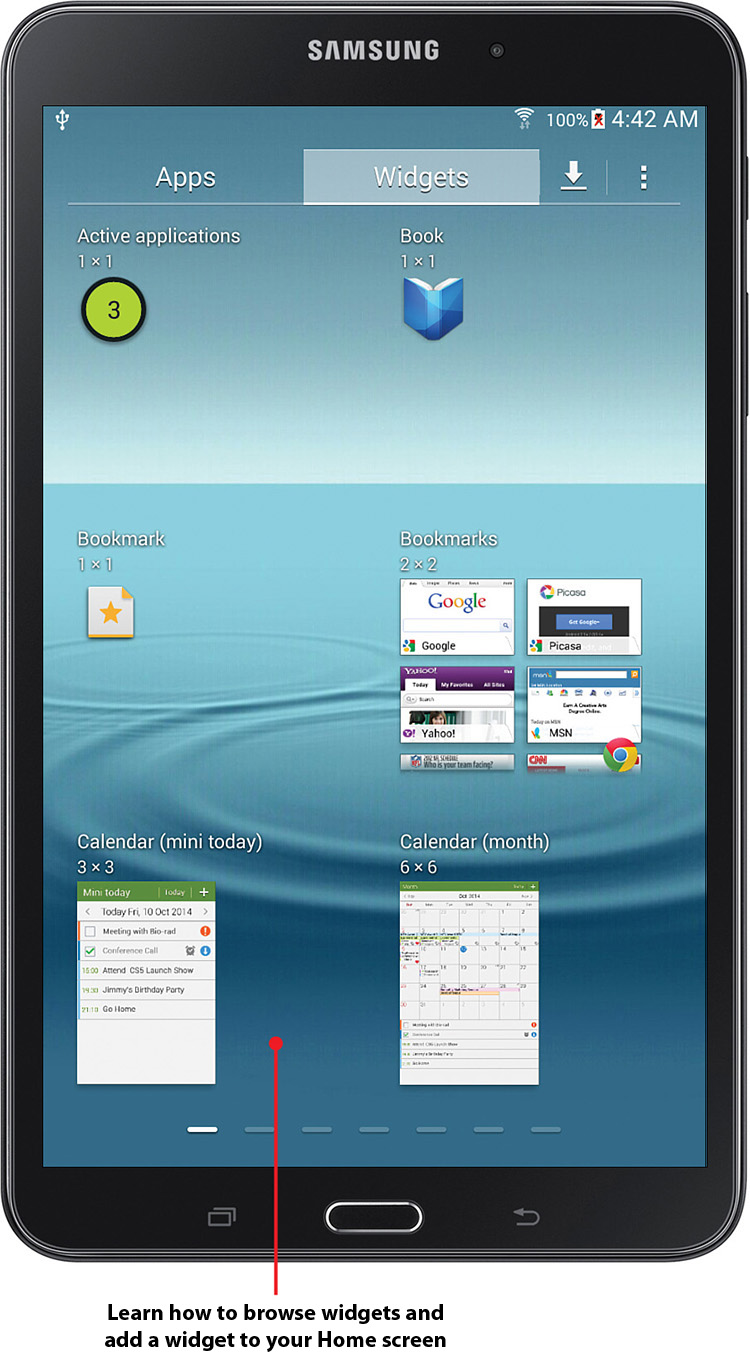
Widgets are a truly valuable aspect of the Android platform. A widget is a small, portable piece of code that you can interact with like a miniature application. Your Galaxy Tab 4 has quite a few widgets for you to choose from that can make your Tab experience even more convenient. This chapter covers the following:
![]() Taking a tour of available widgets
Taking a tour of available widgets
![]() Adding a widget to a Home screen
Adding a widget to a Home screen
Accessing the Widgets Screen
You can find widgets on the Widgets screen, where 40 preinstalled widgets for different tasks are listed. Tapping a widget can provide you a variety of information such as stock market news or the weather. (By default, you have a weather widget on your Home screen.) A widget can also act as a world clock or initiate functionality from a parent app, such as Maps, when you tap it. Though you can apply widgets to a Home screen, some widgets must be configured.
1. Tap the Apps icon on the Home screen.

2. Tap Widgets.

3. Scroll left and right through the pages of widgets. The number of pages depends on the Galaxy Tab 4 model you have and your screen orientation.
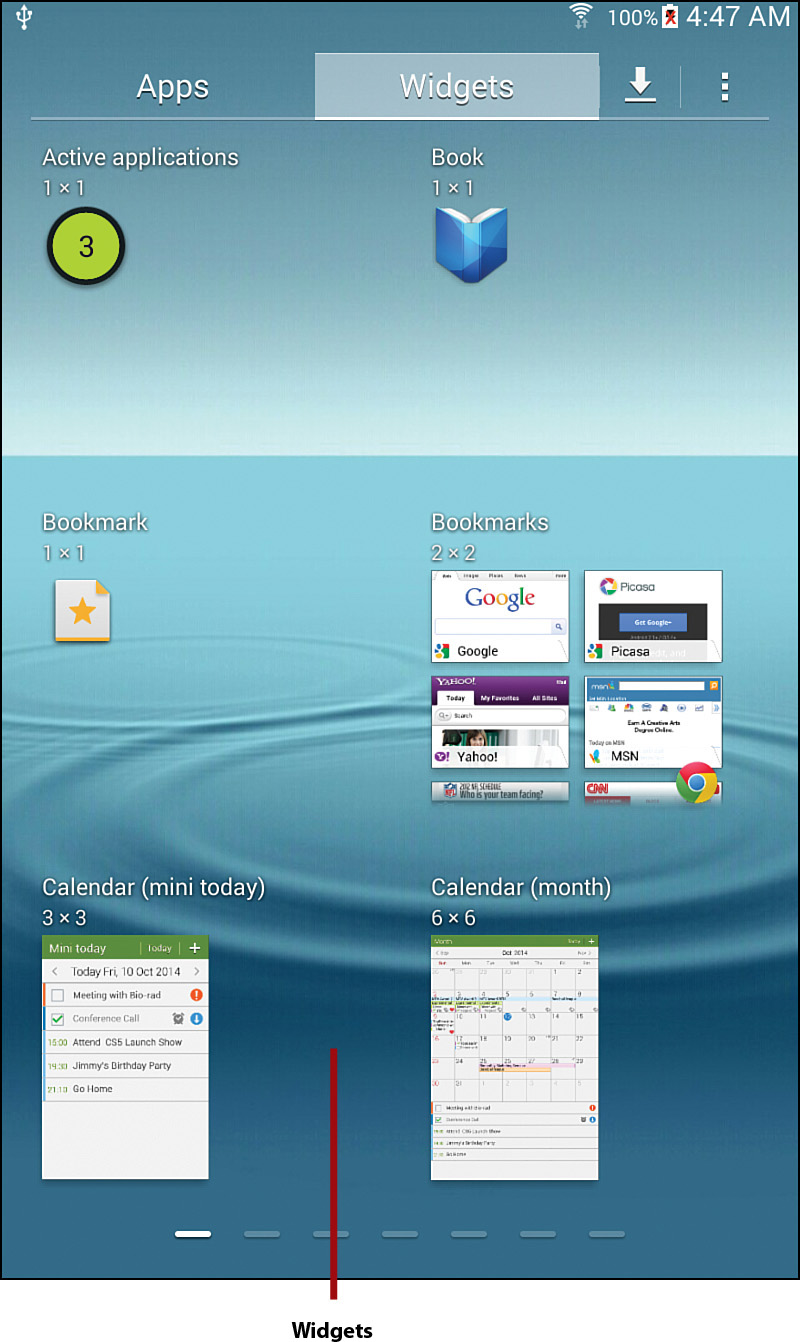
Taking a Tour of Available Widgets
Each widget on the page contains the name of the widget, the size of the widget (width by height in number of grid spaces), and a thumbnail-sized graphic that shows you how the widget will appear on the Home screen. Note that if you want to see how big a 1 × 1 icon is, the Book widget icon that belongs with Step 2 in the next task is sized at 1 grid space wide by 1 grid space high.
All the widgets listed in this section are available on all Galaxy Tab 4 models. On the Galaxy Tab 4 8", which is used for the screenshots in this section (and throughout most of this book), six widgets appear on each of the eight pages within the Widgets screen.
Examine the Page 1 Widgets
1. Active Applications: Opens the Task Manager screen so you can see all active applications, view downloaded apps, and manage memory and storage.
2. Book: Opens the Google Play Books app and shows you a list of all books you’ve downloaded.
3. Bookmark: Opens the Internet app so you can select a bookmarked website on the Choose a Bookmark screen. After you select the bookmark in the appropriate folder, the bookmarked website appears as an icon on the Home screen. View the website in the Internet app by tapping on the bookmark icon.

4. Bookmarks: Places a larger widget on the screen so you can select a bookmark from directly within the widget. Swipe up and down within the widget to view folders and then tap a folder name; after you find the bookmark you want within the folder you tap it. The website appears in the Internet or Chrome app. When you return to the Home screen, you can navigate to and open a bookmark from within the widget.
5. Calendar (mini today): Displays a small calendar for the current day that shows a brief list of your appointments that day.
6. Calendar (month): Displays a large calendar for the current month that shows a brief list of your appointments every day during the month as well as a list of your appointments for the current day.
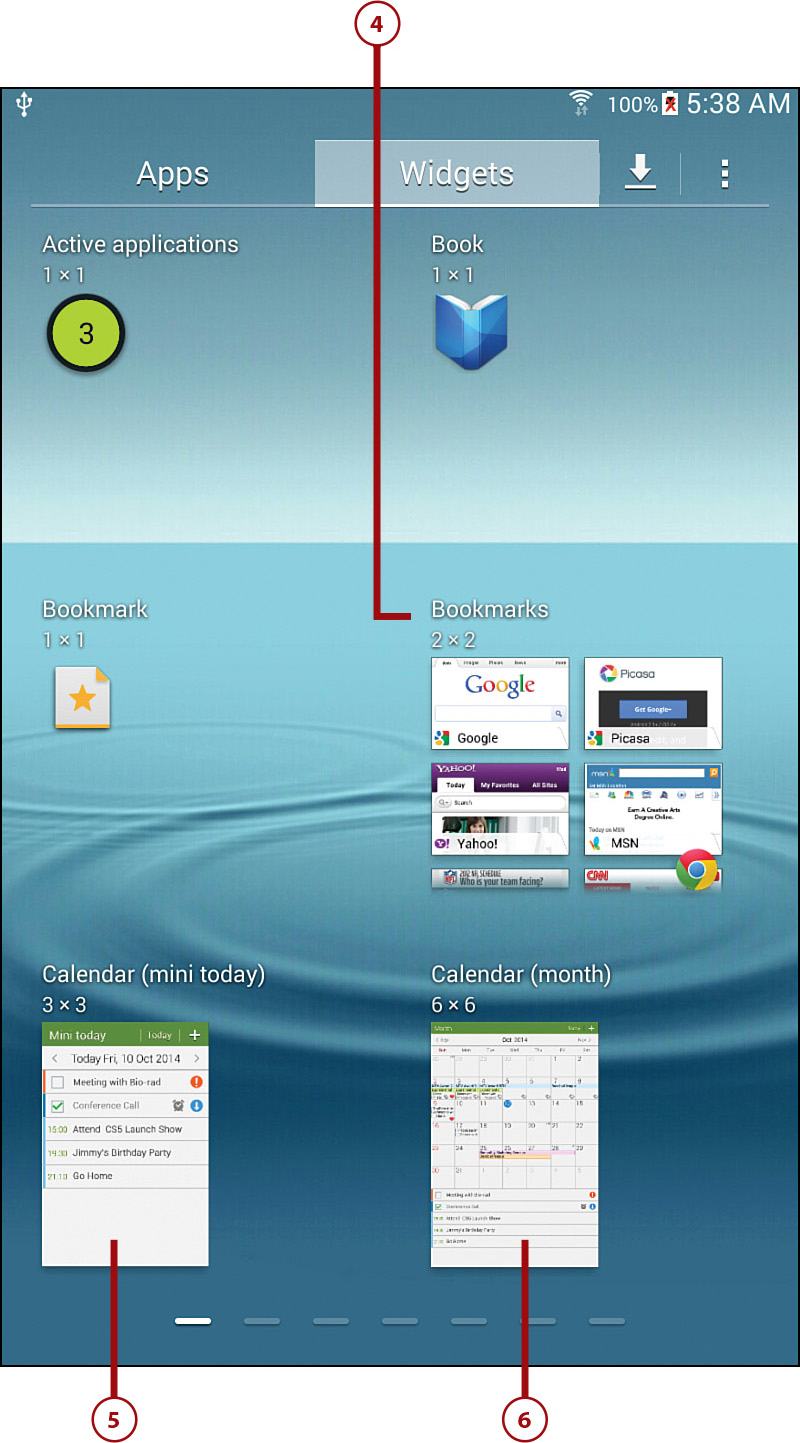
Examine the Page 2 Widgets
1. Calendar (month): Displays a small calendar for the current month that shows a brief list of your appointments every day during the month.
2. Contact: Opens the Contacts window app so you can select the contact to display in the widget. After you select the contact, the picture of the contact appears on the Home screen. Tap the contact picture to open the contact window.
3. Directions: Opens the Directions app so you can enter your destination address from your current location to get turn-by-turn directions.
4. Drive: Displays a small Drive bar so you can open files and folders on your Google Drive online file storage service account.
5. Drive Scan: Opens the Upload Scans To window so you can have the Tab 4 upload screenshots to a selected folder on Google Drive.
6. Drive Shortcut: Opens the Create Shortcut To window so you can have the shortcut widget on the Home screen take you directly to a file or folder stored on Google Drive.
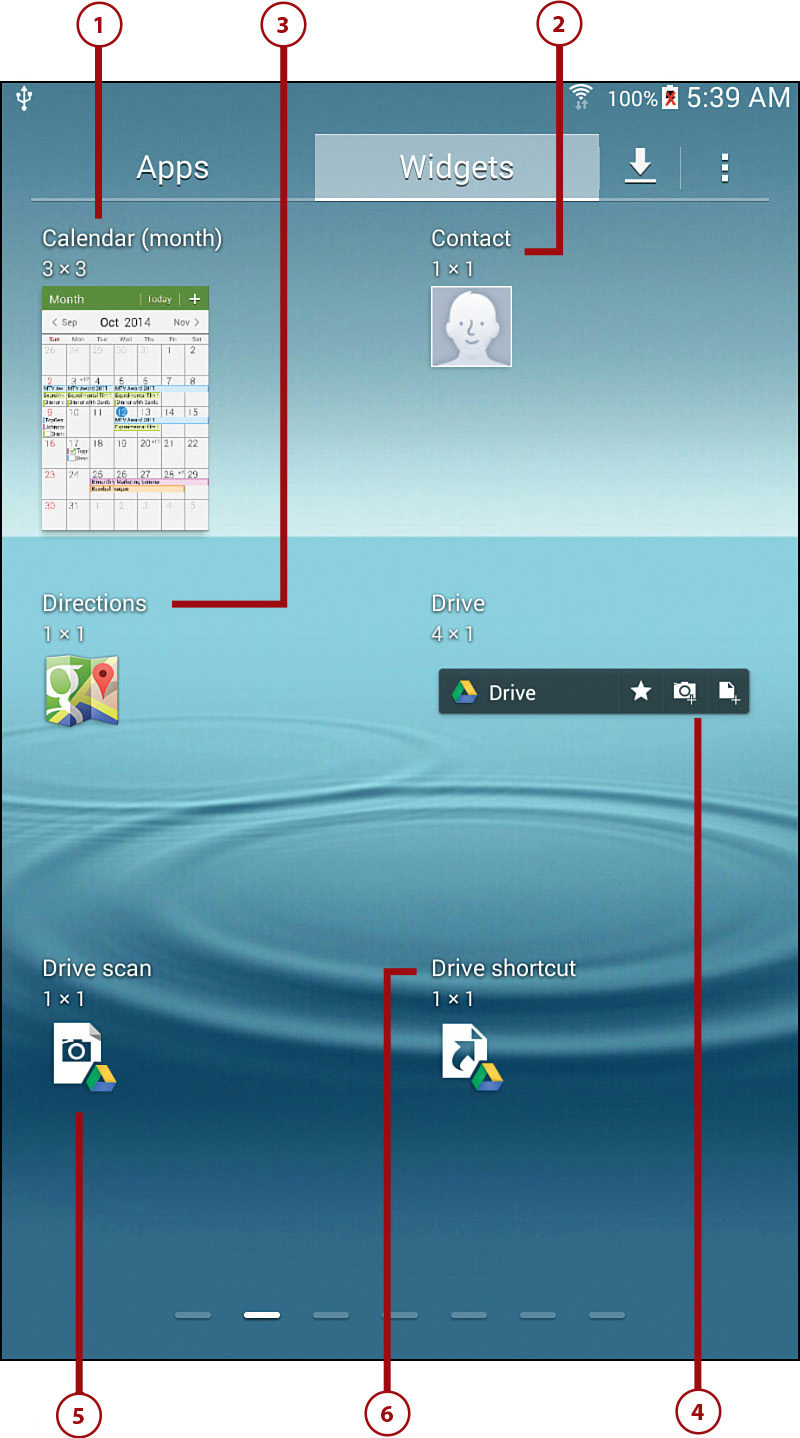
Examine the Page 3 Widgets
1. Dropbox Folder: Places a Dropbox folder link on your Home screen. You have to open the Dropbox app and log in before you can add this widget. After you log in, you can select the folder to which you want to link in the Create Shortcut window.
2. Dual Clock (Digital): Shows times in two different cities as digital clocks. The current date appears below the time for each city.
3. Email: Shows the most recent five email messages that are aggregated from all your inboxes. After you add the app to a Home screen, set up the Samsung Email widget app by tapping the widget.
4. Gmail: Shows the most recent three messages you received in your Gmail inbox. When you add the app to a Home screen, the Choose Folder window appears so you can select the folder that contains messages you want to read. After you tap the folder name, the most recent messages within that folder appear on the Home screen.
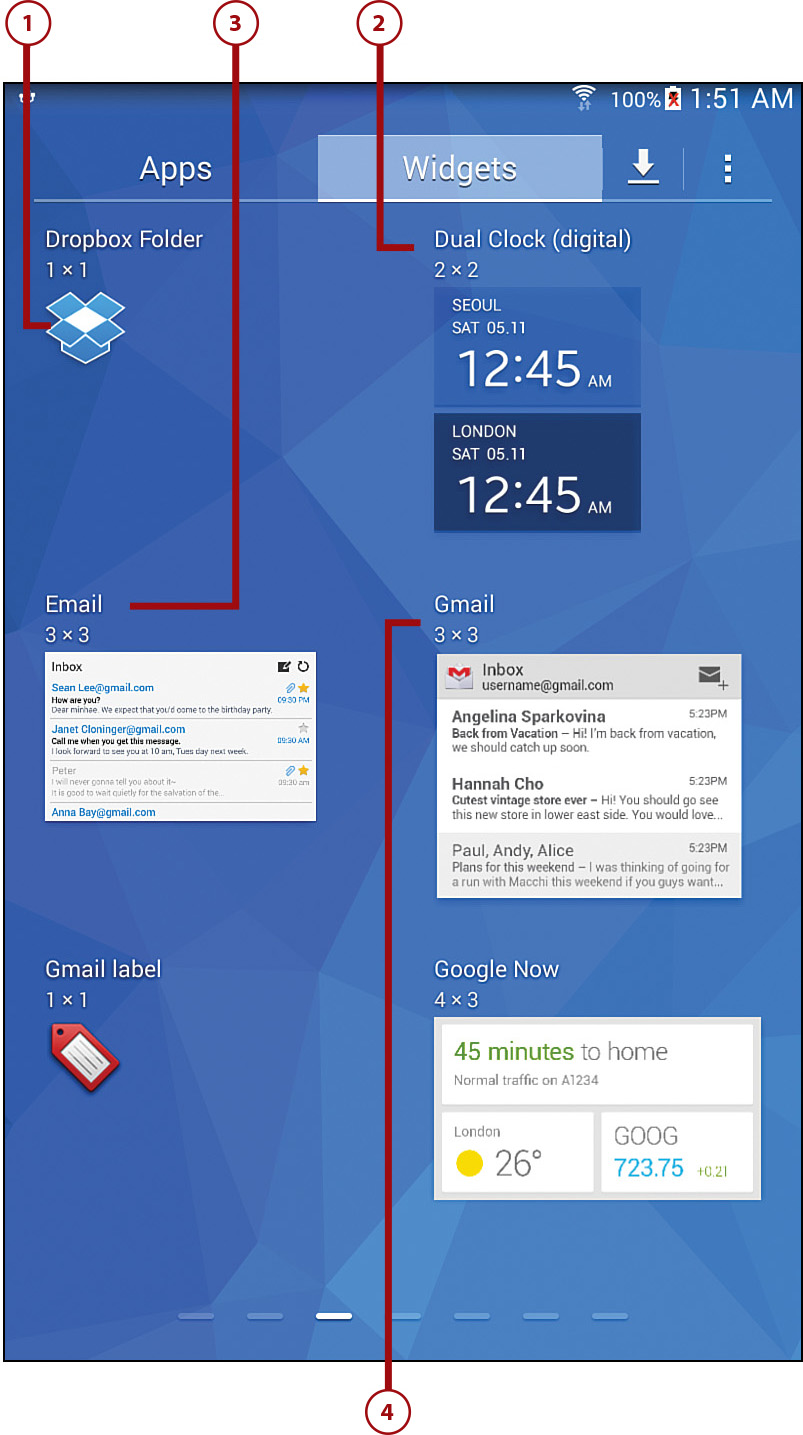
5. Gmail Label: Adds a Gmail Label, which acts as a shortcut that opens a Gmail folder. When you add the app to your Home screen, the Choose Folder window appears and asks you to select a Gmail folder. The Name Label Shortcut window appears so you can accept the folder name as the shortcut name or type a new name. Tap Done in the window to view the Gmail Label widget on the Home screen.
6. Google Now: Displays basic Google Now app information such as a brief weather forecast and information about your next appointment. Open the Google Now app and get more information by tapping on the widget on the Home screen.

Examine the Page 4 Widgets
1. Google Play Books: Opens the most recent book you read in the Google Play Books app. The cover of the most recent book you read appears in the widget icon.
2. Google Play Music: Plays the next song in your Google Play Music playlist when you tap the Play button in the Google Play Music widget. Open the Play Music app by tapping the thumbnail-sized image on the left side of the widget.
3. Google Play Music: Opens the Google Play Music app so you can select a song to play on your Tab 4.
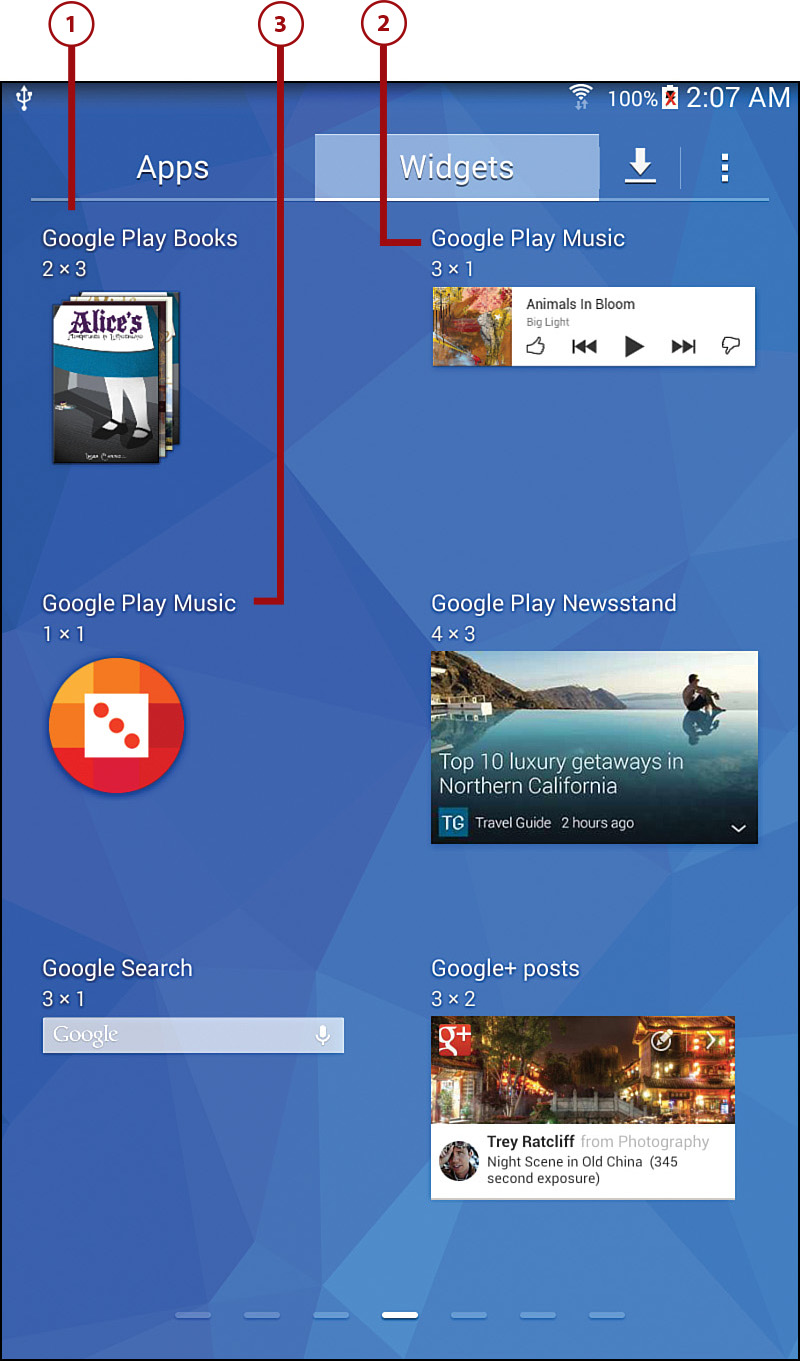
4. Google Play Newsstand: Displays a slideshow of the latest news stories available in the Google Play Newsstand app. Move to the next slide in the slideshow by tapping the down arrow button in the lower-right corner of the widget. Open the Play Newsstand app by tapping the thumbnail-sized image within the widget.
5. Google Search: Adds a transparent Google Search box to the home page; this widget box appears on the main Home screen by default.
6. Google+ Posts: Displays your latest Google+ posts within the widget. Open the Google+ app and view the most recent post by tapping the widget in the Home screen.

Examine the Page 5 Widgets
1. Google+ User Locations: Tells you where your Google+ friends are currently when you’re signed into Google+.
2. Hancom Office: Shows a list of available files you can open within the Hancom Office app. Tap the file to open the Hancom Office app and view the file contents. You can read more about using Hancom Office in Chapter 15, “Using Apps for Learning, Creating, and Sharing.”
3. Hangouts: If you’re in a Google Hangout, this widget shows you the conversation within the widget without requiring you to be within the Hangouts app itself. Therefore, you can keep track of the conversation while performing other tasks on your Tab 4.
4. Magazine Here & Now: Installs the My Magazine app on your Tab 4 and then displays a slideshow of the app’s latest magazine articles. You can move between slides by tapping the left and right arrow buttons on either side of the widget. Read an article by tapping the thumbnail image within the widget. You can read more about the My Magazine app in Chapter 13, “Reading and Managing Books and Magazines.”
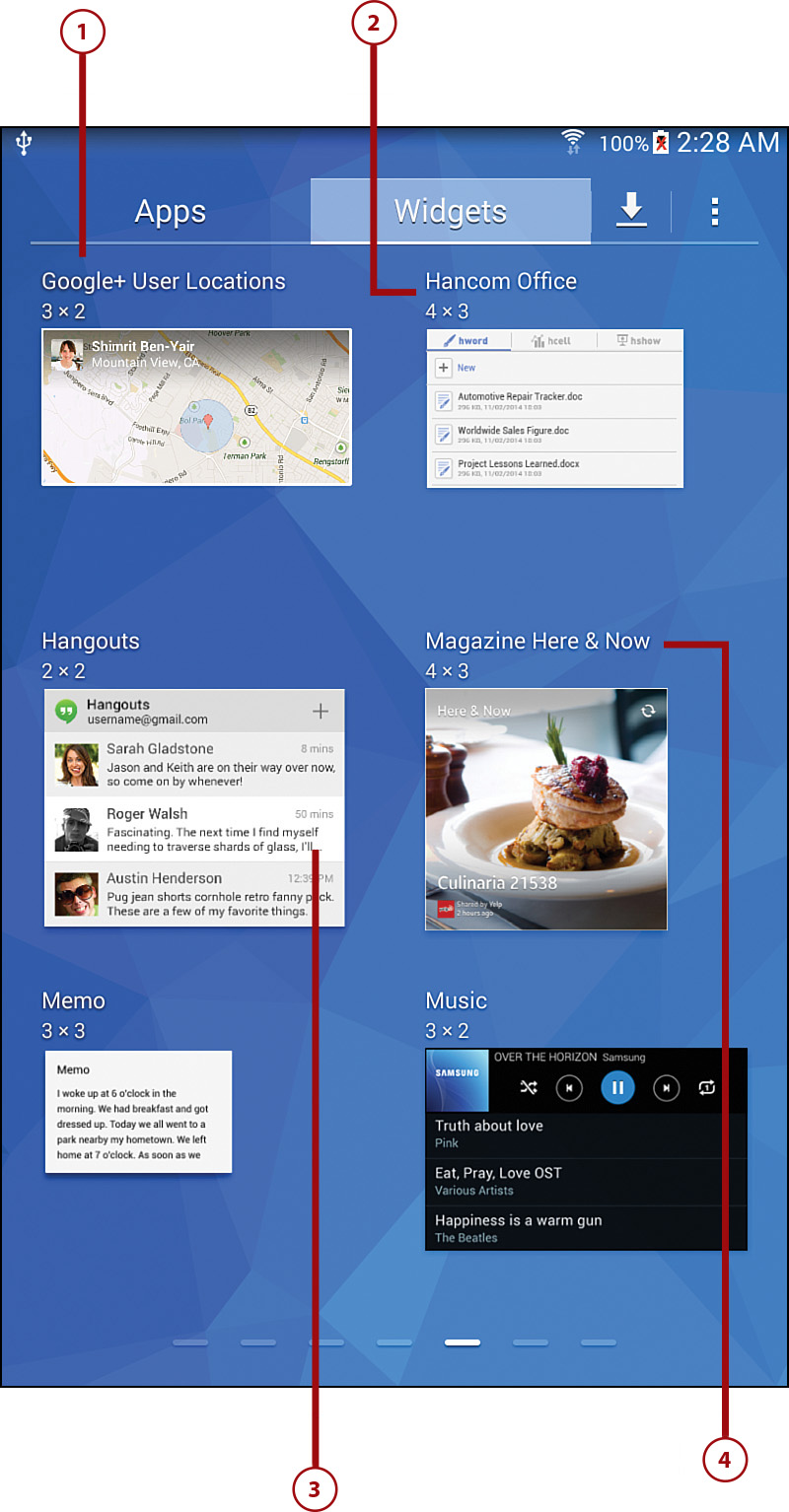
5. Memo: Enables you to write a new memo that will be easily accessible on your Home screen. When you add the memo to the Home screen, the Memo window displays so you can type your memo. After you save the memo, the memo icon appears on the Home screen so you can open it quickly.
6. Music: Displays the Samsung Music Player app that enables you to play songs stored on your Galaxy Tab 4 within the widget itself. For example, you can tap the Play button within the widget to play the song at the top of the list.
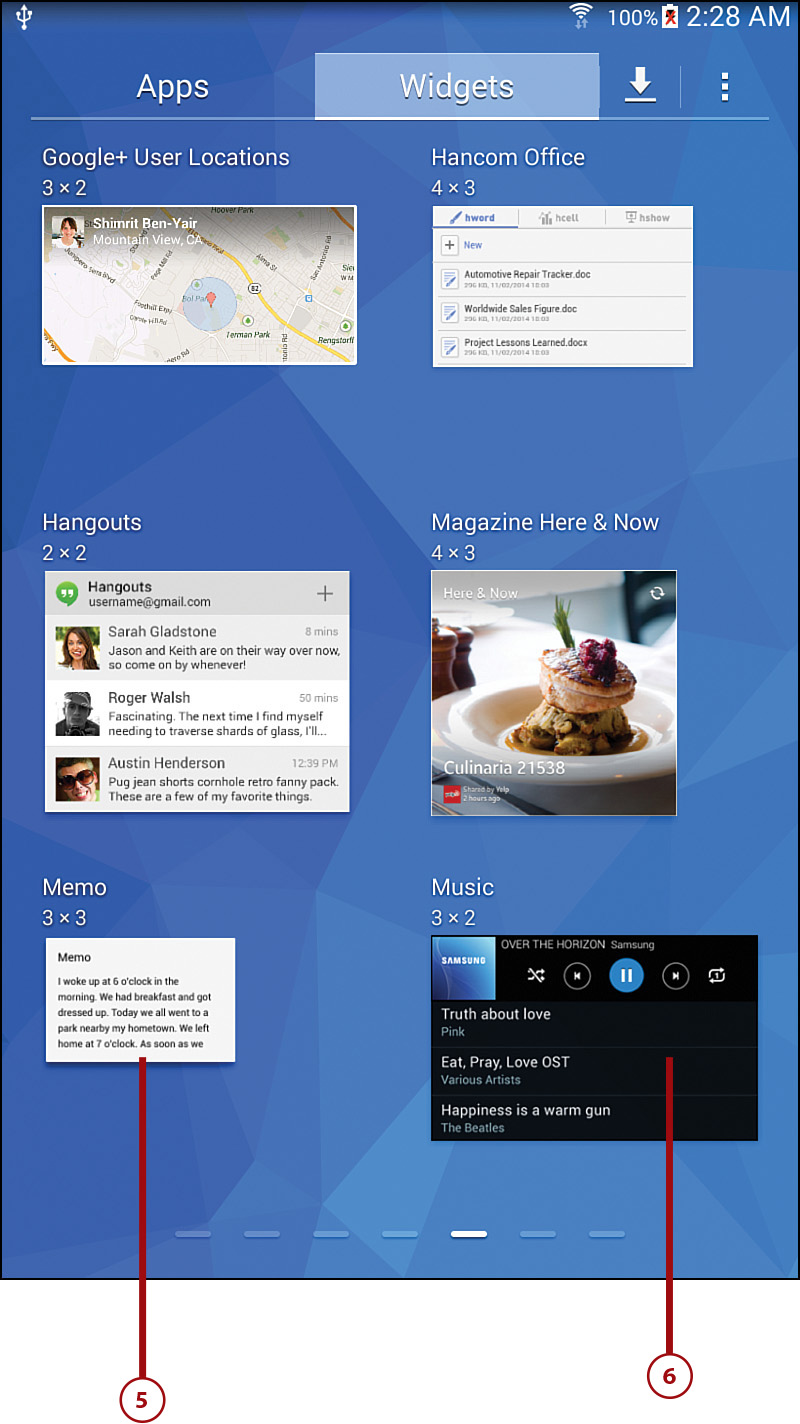
Examine the Page 6 Widgets
1. Music Playlist: Opens the Play Music app window so you can select a playlist that contains the songs you like. After you tap the playlist you want, the playlist icon and name appear on the Home screen. Tap the playlist icon to start playing songs within that playlist.
2. Picture Frame: Displays one or more of your selected pictures stored on your Tab 4 within an area on the Home screen.
3. Play—My Library: Shows contents of one or all of the Google Play apps. For example, the My Books library shows covers of the most recent books you read. Read the book in the Play Books app by tapping the book cover.
4. Play Recommendations: Displays Google Play Store recommendations in one category (for example, Apps) or in all categories. View the recommended app or multimedia file by tapping the widget.
5. Play Store: Displays a slideshow of new and interesting apps in the Google Play Store. Open the Play Store app by tapping the widget.
6. S Bookmarks: Displays your website bookmark folders. Open the list of bookmarks by tapping the bookmark folder and then tap the bookmark tile to open the website in the Browser app.

Examine the Page 7 Widgets
1. Samsung Apps: Displays suggestions for new apps in the Samsung Apps Store that you can install on your Tab 4. You can read more about installing new apps in Chapter 16, “Finding and Managing Apps.”
2. Video: Places a link to a selected video on the Home screen; the title appears in the widget. Play the video in the Video app by tapping the widget.
3. Weather and Briefing: Displays the current weather for your location and reminders (such as incoming e-mail messages) on the Home screen. This widget appears on the main Home screen by default.
4. YouTube: Displays a slideshow of the most recent YouTube videos within various categories such as Most Popular. View the featured video in the slideshow within the YouTube app by tapping the image of the video in the widget.
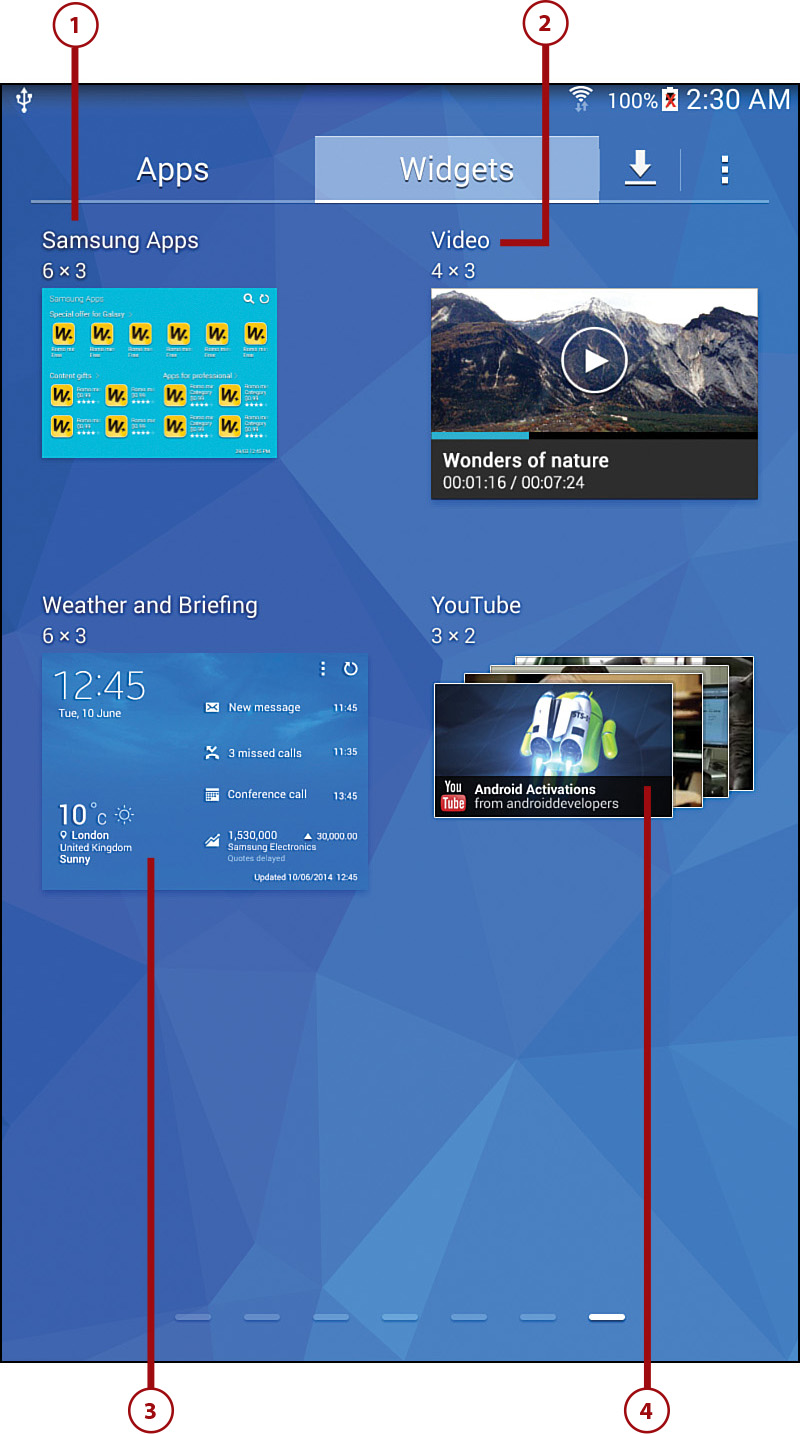
Adding a Widget to a Home Screen
It’s easy to add a widget from the Widgets screen to an existing Home screen or a new one that you create. When you add a Widget to a Home screen you can specify where that widget—either an icon or the widget area—will reside on the Home screen. If you decide that you want to move the widget to a different location on a same or a different Home screen, you can drag the widget to that new location on the current Home screen, another existing Home screen, or a new Home screen that you create.
Some widgets also enable you to change the size of the widget before you place it on your desired Home screen. If the widget you’re trying to add to an existing Home screen won’t fit on that Home screen then KitKat adds a new Home screen automatically and places the widget on that new Home screen.
Place a Widget on a Home Screen
1. Tap the Apps icon on the Home screen.

2. Tap Widgets at the top of the Apps screen.
3. Navigate to the page that contains the Dual Clock (Digital) widget used for this example.

4. Press and hold your finger on the Dual Clock (Digital) widget. The Edit Home screen appears; the Home screen appears in a smaller area of the screen and the widget you’re moving appears as an outline on the screen.
5. Move the outline over the Home screen to which you want to add the widget. The Home screens appear as small thumbnail buttons at the bottom of the screen and each button contains different elements as they appear on the Home screen. The Home screen buttons appear in a row of three and the main Home screen (the one that opens when you start your Galaxy Tab 4) appears second from left in the row.

6. Release your finger. The widget appears at the top left of the screen by default. If any other widgets appear on the screen then the Dual Clock (Digital) widget appears to the right of the widget or on the left side of the screen underneath a row of widgets.
7. The Dual Clock (Digital) widget lets you configure the information that it displays. Add a new city by tapping the Tap to Add City box.

8. Swipe down the list of cities and tap one. For example, perhaps a friend has traveled to Rome for the summer and you don’t want to call her in the middle of the night. Swipe down the list of cities and then tap Rome.
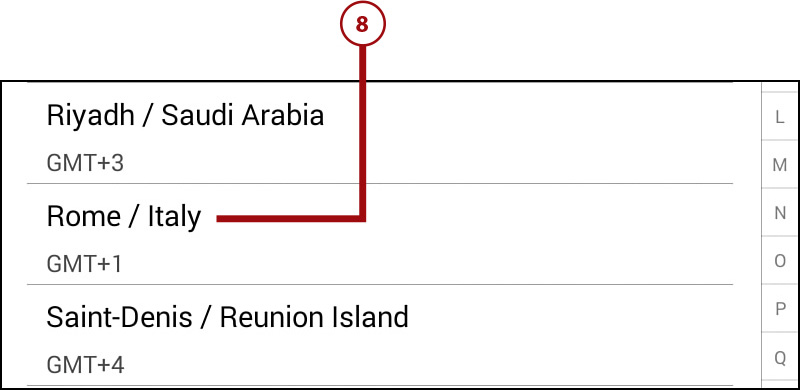
9. Rome is added to the clock, and now you know the current time for the city where your friend is staying.

10. Tap either city to change to a different city. You can search for a city by typing the city name in the Search Cities box.

Move a Widget on a Home Screen
You can move a widget to a different location on the same Home screen by tapping and holding the widget within the Home screen. This example shows how to reposition the Dual Clock (Digital) widget.
1. Tap and hold the widget you want to move. The widget outline appears on a smaller version of the Home screen so you can see where you can move the widget.
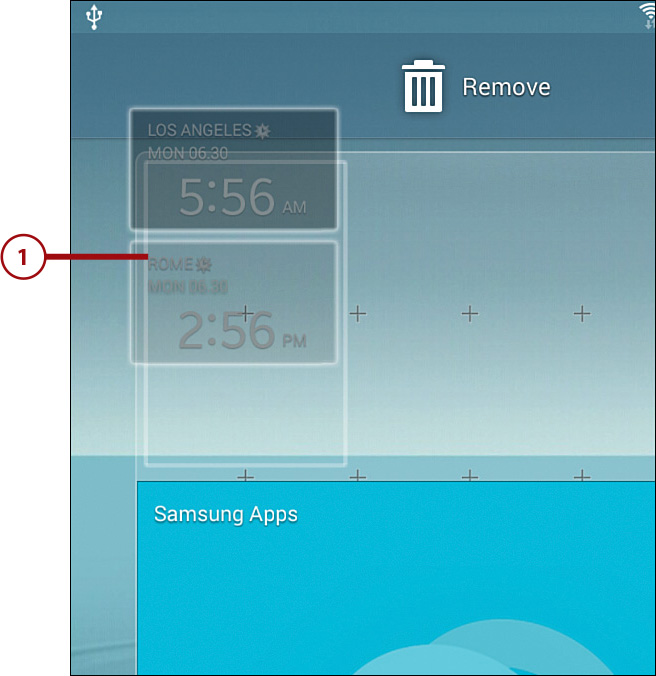
2. Drag the widget to the new location on the Home screen. The Home screen is ordered in a grid format and + signs within the Home screen denote grid corners. As you move the widget to the new location, a lighter copy of the outline appears below and to the right of your widget outline. This lighter outline copy denotes where your widget will reside on the screen. If there’s a widget that already resides in the location you want, the widgets reposition themselves on the screen to accommodate your desired location for the widget.

3. Release your finger. The widget appears in your desired location.

Resize a Widget
Some widgets come in a preset size. Others allow you to change the size of the widget when you add it to the Home screen. You can also change the size of an adjustable widget after you add the widget to a Home screen. This example describes how to add the Gmail widget.
1. Tap the Apps icon on the Home screen.

2. Tap Widgets at the top of the Apps screen.

3. Navigate to the page that contains the Gmail widget.
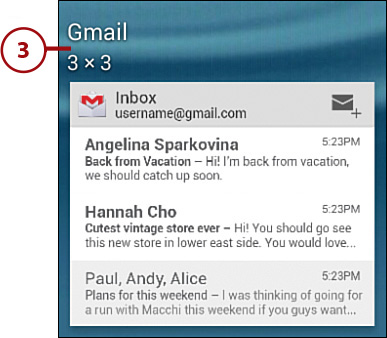
4. Press and hold your finger on the Gmail widget. An overlay of the Home screen that you chose appears and the widget you’re moving appears as an outline on the screen.
5. Move the outline over the Home screen to position the widget within the screen. When you’re satisfied with the location of the widget on the Home screen, release your finger.
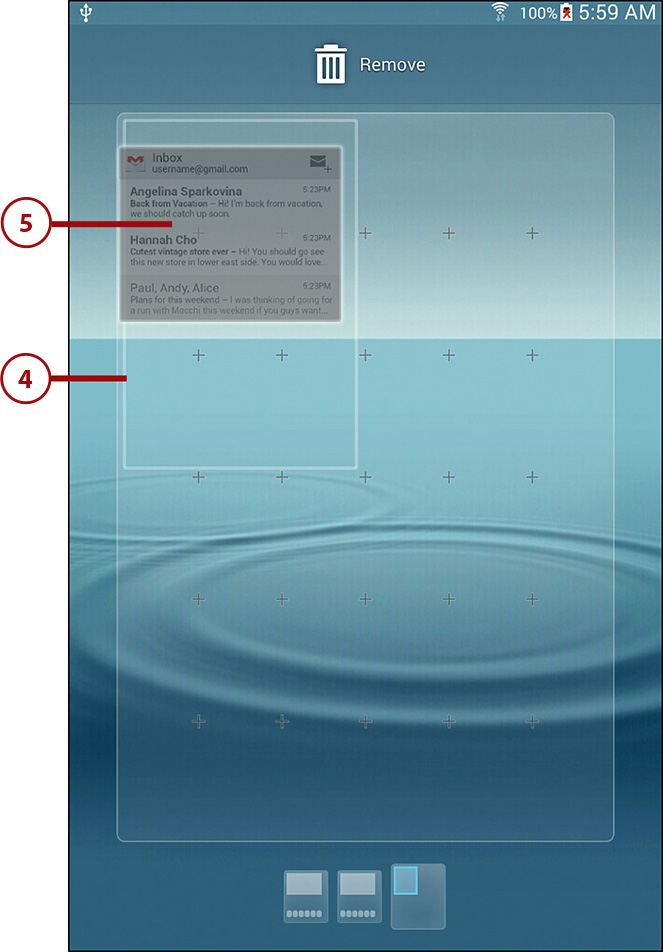
6. In the Choose Folder window, tap the Gmail folder you want to display in the widget within the list.
7. The widget appears on the Home screen with an orange box around it. Orange circles, or handles, appear on all four sides of the box.
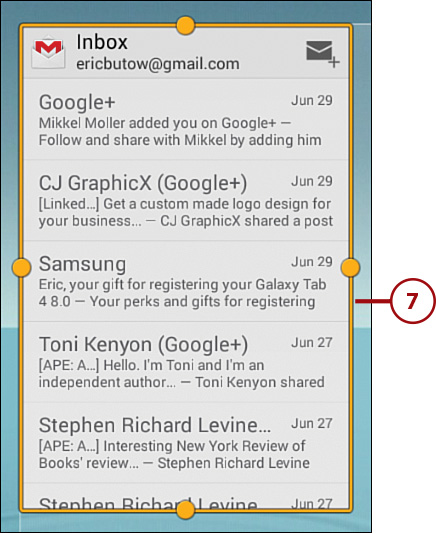
8. Resize the widget by tapping and holding on one of the handles and then dragging left and right or up and down depending on the handle you’re moving. For example, if you drag the bottom handle up and down then you change the height of the widget. If your widget size is too large for the available area on the Home screen then the box and handles turn red to tell you that the widget is too large for the available space.
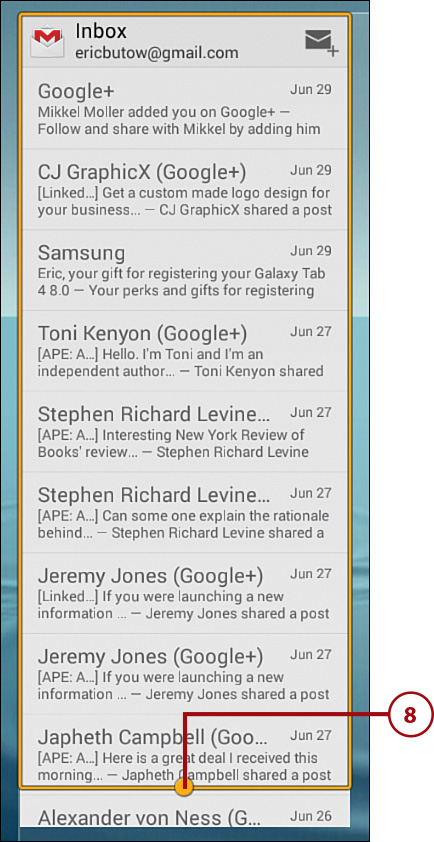
9. Release your finger. The resized widget appears on the Edit Home screen. If the widget is too large for the area you want, KitKat automatically resizes the widget to fill the available width or height.
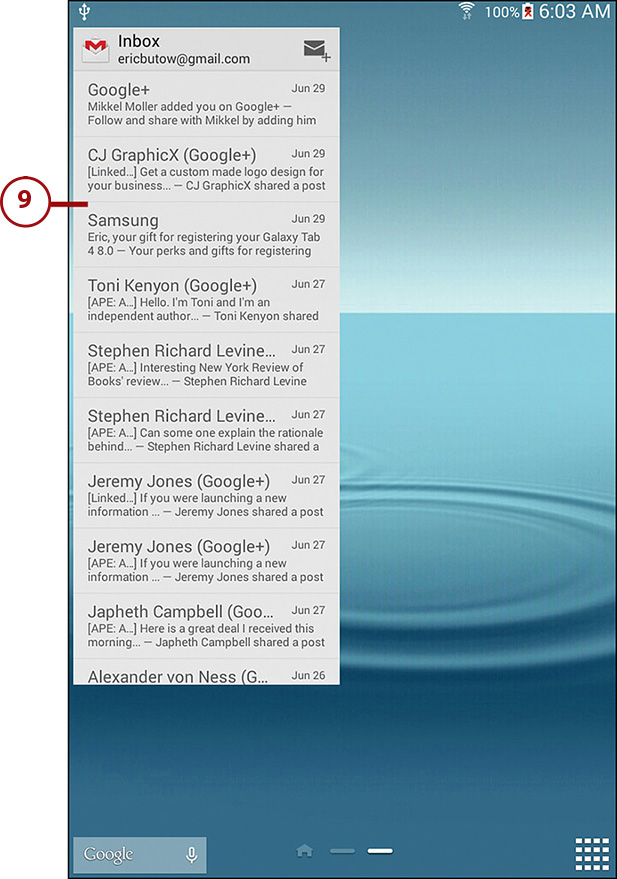
10. Tap the Back touch button. Your widget appears on the Home screen at your desired size.
Creating a New Home Screen
A task earlier in this chapter describes how to create a new Home screen when you add a new widget. There are two other ways to create a new Home screen: from within an existing Home screen and in the Home screen menu.
1. Tap and hold your finger on a blank area of the Home screen until the Home Screen window appears. A blank area is an area that isn’t occupied by another feature such as a widget or icon.
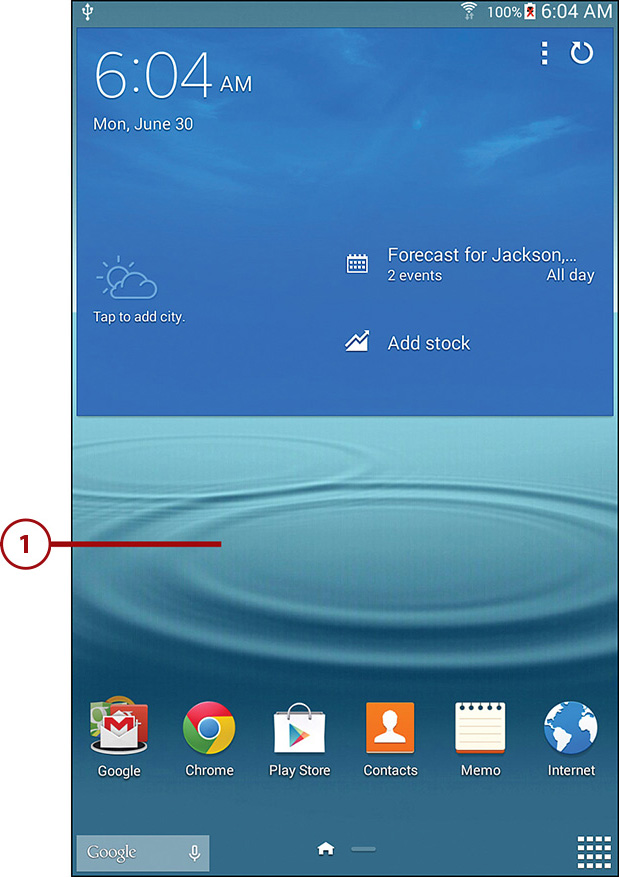
2. Tap Page in the menu.
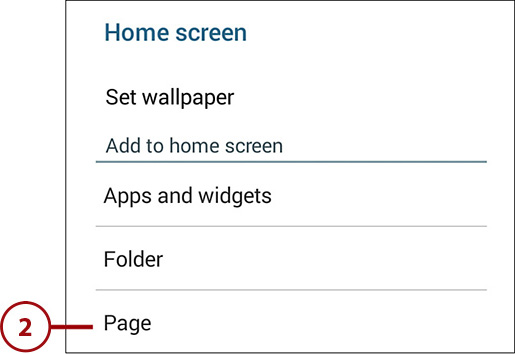
3. The new Home page appears on the screen and the selected Home page appears to the right of the main Home page. The main home page is denoted by a house icon and the new home page you’re viewing is denoted by a white bar.
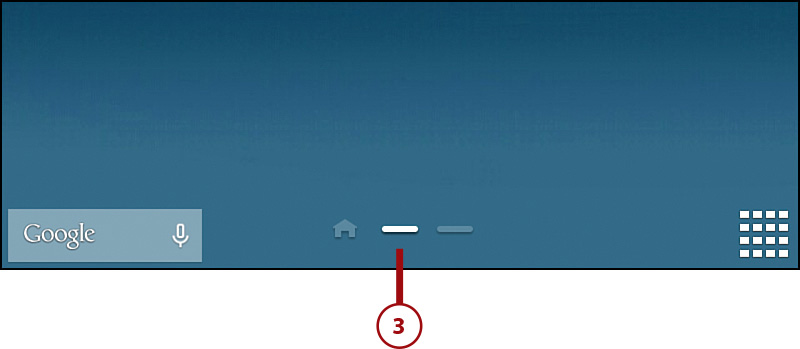
4. Tap and hold the Recent touch button until the Edit Page screen appears.
5. Tap the Add Page button in the Edit Page screen.
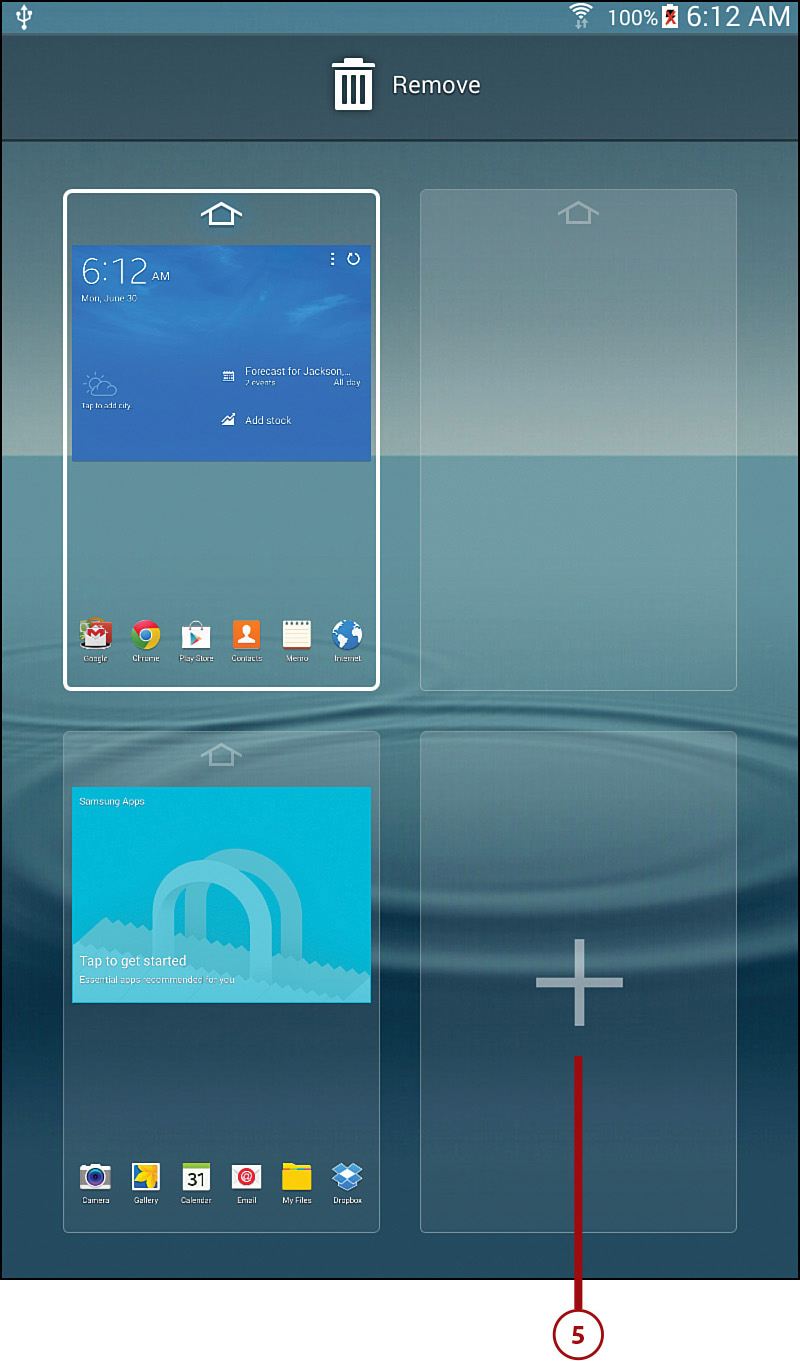
6. The button for the new Home page appears on the screen. Open the new Home page by tapping the button.
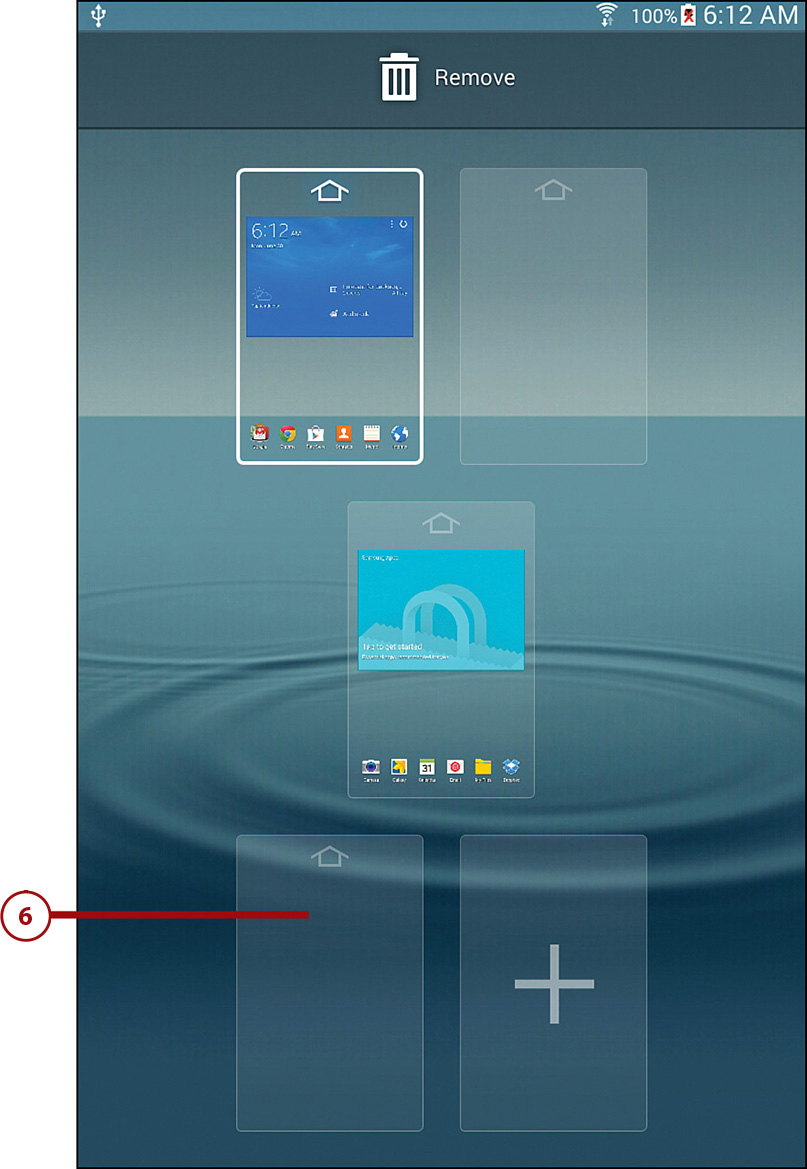
Removing a Widget
It’s easy to remove a widget from a Home page if you decide that you don’t want it any longer.
1. Navigate to the Home page that contains the widget you want to remove. Tap and hold on the widget.
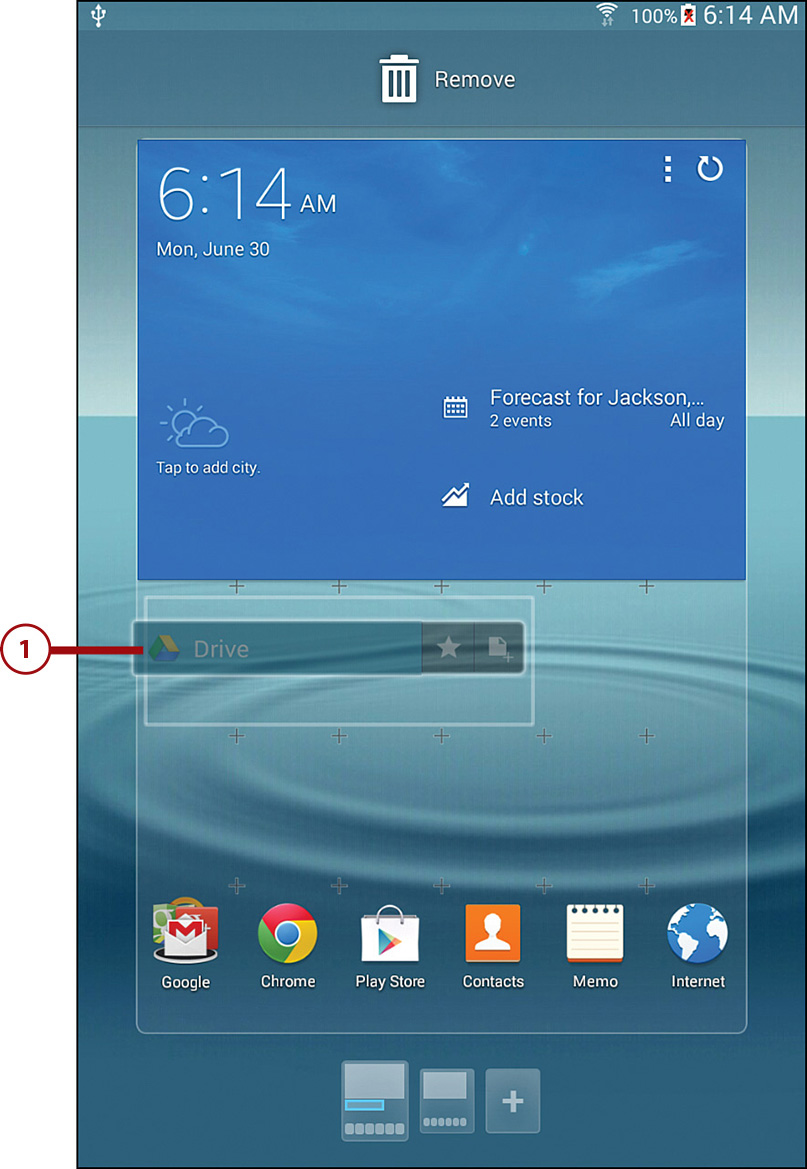
2. Within the Edit Home Page screen, drag the outline of the widget to the Remove icon at the top of the screen. When the Remove icon is highlighted in red, release your finger.
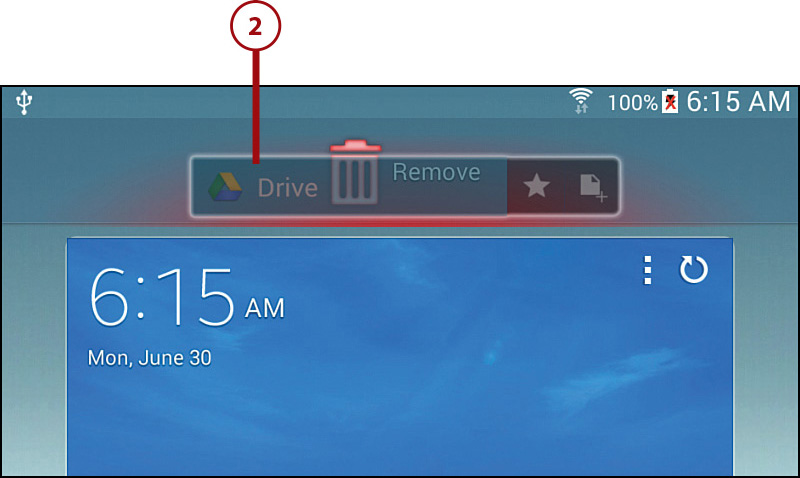
3. The Home screen appears and no longer contains the widget you removed.
